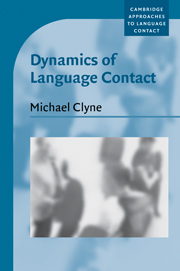Book contents
- Frontmatter
- Contents
- List of map and figures
- List of tables
- Series editor's foreword
- Acknowledgments
- List of abbreviations
- 1 Introduction
- 2 Dynamics of language shift
- 3 On models and terms
- 4 Dynamics of convergence and transference
- 5 Dynamics of transversion
- 6 Dynamics of plurilingual processing
- 7 Dynamics of cultural values in contact discourse
- 8 Towards a synthesis
- Notes
- References
- Index of authors
- Index of languages
- Index of subjects
4 - Dynamics of convergence and transference
Published online by Cambridge University Press: 18 December 2009
- Frontmatter
- Contents
- List of map and figures
- List of tables
- Series editor's foreword
- Acknowledgments
- List of abbreviations
- 1 Introduction
- 2 Dynamics of language shift
- 3 On models and terms
- 4 Dynamics of convergence and transference
- 5 Dynamics of transversion
- 6 Dynamics of plurilingual processing
- 7 Dynamics of cultural values in contact discourse
- 8 Towards a synthesis
- Notes
- References
- Index of authors
- Index of languages
- Index of subjects
Summary
Introduction
This chapter is about how bilinguals and trilinguals make their languages more similar (convergence) – and how some of them, having done this, try to differentiate them in particular ways (divergence). The chapter utilizes Australian data from bi- and trilinguals as an example to focus on the following issues:
The ways in which the resources of two or more languages are employed and how these ways might be connected.
How the language systems converge and how such convergence is resisted by some speakers.
How languages change differentially in the context of, and under the influence of the same language in contact.
How and to what degree material from one language is integrated into another.
What facilitates transference from one language to another and how this varies between languages in contact.
The applicability of current models to the above issues.
Clearly there are many other issues that can be dealt with using a comparative corpus, but time and space require a selection.
Issue 1 above is the main concern of virtually all linguistic studies of language contact. Issue 4 is of paramount importance in some publications because it is a special issue in contact between certain pairs of languages (e.g. Backus 1996; Boeschoten 1998; Halmari 1997) and because traditionally it underlies the distinction between ‘code-switching’ and ‘borrowing’. Some discussion on current models and their applicability may be found in chapter 3.
- Type
- Chapter
- Information
- Dynamics of Language ContactEnglish and Immigrant Languages, pp. 103 - 158Publisher: Cambridge University PressPrint publication year: 2003



